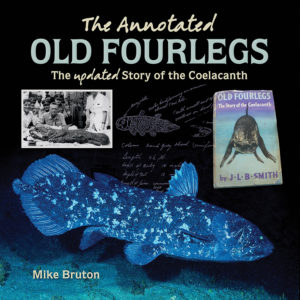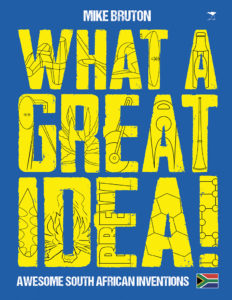By Steven Lang
While most of us would be proud if we could only read two books in a a week, Prof Mike Bruton launched two books in quick succession in Grahamstown last week. Bruton launched The Annotated Old Fourlegs – The updated story of the Coelacanth on Thursday and then the very next day he unveiled his What a Great Idea – Awesome South African Inventions.

He rather appropriately launched The Annotated Fourlegs at the South African Institute for Aquatic Biodiversity (SAIAB) where a preserved coelacanth guards the reception area.
The coelacanth is a rare fish that until 1938 was believed to be extinct since it was only known from fossils, many of which are considerably older than the dinosaurs.
The legendary ichthyologist, Prof JLB Smith published the original Old Fourlegs book in 1956 almost 18 years after the first modern coelacanth was hauled up from the ocean off the coast of East London.
Bruton said his motivation for republishing Smith’s book with the annotations was to “keep the coelacanth story alive. I think it’s such an inspirational story. I know of many ichthyologists whose careers, were kicked off by reading Old Fourlegs”.
He explained that on his bookshelves he had a copy of The Annotated Alice and appreciated how much value the annotations added to Lewis Carroll’s classic so he thought he could do the same for Old Fourlegs.
The original copy of Smith’s book has not been altered at all which means there are “a few hair-raising and racist comments in it. We’ve decided to leave those in. ‘Cause that’s how they wrote in 1956”.

He stressed the importance of inspiring young people to study ichthyology because science is under pressure at the moment. This is true not only in fundamentalist countries but even in South Africa, where people are questioning the value of science and challenging notions of African science versus Western Science.
Bruton insists that there is only one science and it is therefore important to communicate science to non-scientists. He explains that science communication needs to be accessible and exciting that is why the coelacanth story is a great way of conveying the importance of the scientific method.
He adds that the coelacanth has also become a symbol of marine conversation. This ambassadorial role is important because “our oceans are in serious trouble, possibly even worse trouble than on land”.
The Annotated Old Fourlegs was written for a wide audience because if you don’t want to read the whole book “you can read the annotations in the margin. And the introduction and concluding chapters are written in bite-sized chunks, with sub-headings and lots of illustrations. And in fact it’s a book you can browse through and just look at the pictures and read the captions”.
Bruton said the book he launched at the Albany Museum, What a Great Idea – Awesome South African Inventions, was definitely the hardest he’s had to write because it took him out of his ichthyology comfort zone. He had to do research in many different, unfamiliar areas.
Before he could make his presentation, he had to clear up some definitions. This is important because some people were born in this country, but worked overseas and other people did the exact opposite. Bruton used the term ‘South African’ in the broader sense so that he could include maverick innovator Elon Musk, who was brought up in this Pretoria but now lives in the United States. Other inventors included in his book were born in England but spent most of their productive careers in this country.
What a Great Idea looks somewhat like the Guinness Book of Records. It is colourful, well-illustrated and chock-a-block full of fascinating facts about South African inventions. You can pick it up, read a few entries, put it down and then pick it up again. The chapters and individual entries are self-contained meaning that you are not required to spend long periods glued to the book to maintain your train of thought.
Both books are wonderful potential Christmas gifts – I wouldn’t mind receiving either, or both.
Grey Box
The coelacanth in the words of Prof Mike Bruton
SSL: Where does the coelacanth fit in the evolution of tetrapods?
Prof Bruton: originally it was thought that the coelacanth was most closely related to the beast that crawled out of the water and came on to land and evolved into frogs and then reptiles, birds and mammals – and the reason was because of their lobed fins. We know that the fins have got a strong lobe, it looks like a leg, hence the name ‘Old Fourlegs’, and in those lobes are bones and muscles that would seem to be able to allow it to walk.
But obviously the modern living coelacanth is completely wrong shaped to walk around on land, even on the bottom of the sea. It’s a deep bodied fish. It would have to be much more flat bodied, like a frog to walk, but there were flat bodied coelacanths as well.
But what we now know from DNA and other studies that the lungfish is closer to the evolutionary line of the tetrapods, the four-legged animals. But the coelacanth is very close to that and the nearest living relative of the coelacanth are the lungfishes and they are more closely related to the four-legged animals than they are to normal fishes.’
SSL: Is it still classified as a tetrapod?
Prof Bruton: No, it’s actually classified at the moment as a fish.
SSL: But it’s different to the fish that we normally see, the ray-finned fishes?
Prof Bruton: It’s definitely different to the ray-finned fishes, and to the cartilaginous fishes – the sharks and the rays. And the coelacanth basically, because the group has been around for so long – 418-million years, they’ve sort of followed their own path. They haven’t followed the laws of evolution, ’cause they’ve got a bit of shark in them, a bit of bony fish, bit of frog, bit of reptile – you know they haven’t followed the rules. They’re a very idiosyncratic fish.



